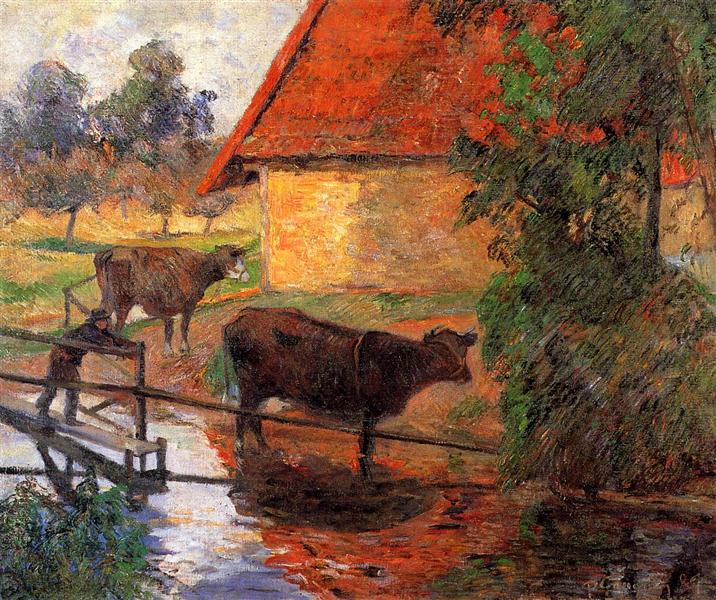Beschrijving
The painting "Spa Resort" from 1885, also known as "Watering Place", is a work in which Paul Gauguin begins to share some of the characteristics that would later define his distinctive style. Belonging to Gauguin's time in Brittany and the period of his life in which he sought a deeper connection with nature and rural life, this painting is set in a context where the artist explores simplicity and the spiritual in everyday life.
The composition of the work is notable for the balanced arrangement of the elements it presents. In the foreground, two female figures, possibly peasants, are visibly engaged in a common, everyday task: feeding goats. The women, who are positioned on the left, are represented in attitudes that evoke a sense of community and labor. Their clothing is traditional, which underlines the connection of these women with their rural environment. The presence of livestock, symbolizing both sustenance and community life, incorporates a sense of humility and reverence towards daily work.
Gauguin displays a vibrant use of color that is characteristic of his later works, although in this painting there is still a more visible connection to Impressionist influences. The green tones of the landscape are enriched by touches of warm yellows, reflecting the interplay of light and shadow in the natural environment. The colors in the painting not only seem to serve a descriptive purpose, but also function to convey emotions, such as a sense of tranquility and harmony with nature. The warm tones contrast with the cool blues of the background, creating a visual balance that invites the viewer to enter into the scene.
The painting's background is equally fascinating; an unbroken landscape stretching out to the horizon, with trees and a sky suggesting the arrival of a peaceful evening. This background serves not only as an aesthetic context, but symbolizes Gauguin's desire to create an idyllic world that transcends the urban struggles of his time. As in other works by Gauguin, there is a recognizable longing for a simpler, more meaningful life, a recurring theme in his artistic quest.
It is interesting to note that although this work is grounded in a more realistic depiction of rural life, elements of the work can also be interpreted through a prism of symbolism that the artist would later embrace. The activity of the women and the goats serve to illustrate a connection between human labor and nature, which is intensified in his later work in Polynesia, where the symbolism alludes to a more spiritual life and one of unity with the environment.
“Spa Resort” can be seen as a bridge between the Impressionism that Gauguin began with and the deeper, richly colored symbolism that would mark his career. This work reflects the earliest manifestations of his unique style, seeking not only to depict tangible reality, but also to explore a vision of life that is both nostalgic and aspirational. In a broader context, Gauguin’s work in this period is pivotal, as it lays the groundwork for his evolution into bolder artistic representation that would challenge the boundaries of art in the 19th century and beyond. His interest in cultural authenticity, the indigenous, and the spiritual would resonate with generations of artists who came after him. In the canvas of “Spa Resort,” we see the germination of ideas that would blossom in later works, marking Gauguin not only as a witness to his time, but as an innovator of the Post-Impressionist movement.
KUADROS ©, a famous painting on your wall.
Hand-made oil painting reproductions, with the quality of professional artists and the distinctive seal of KUADROS ©.
Painting reproduction service with satisfaction guarantee. If you are not completely satisfied with the replica of your painting, we will refund 100% of your money.

